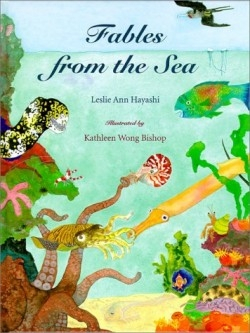Fables from the Sea
Everyone learns a lesson in each of these ten brief fables with characters from tropical ocean waters. Using the natural behavior of marine animals and shore birds as the basis for each story, the author seeks to metaphorically convey important lessons about life.
Values supported by the stories include the importance of kindness in “The Moray Eel and the Little Shrimp,” the need to be polite in “The Impolite Hermit Crab” and truth in “The Sand Castle.” In each fable one of the animals comes away from an experience with greater understanding of his or her place within his environment with the moral being clearly stated at its conclusion.
In “The Flounder’s Vision,” a young flounder is able to play a game of hide-and-seek with other fish until she matures and her eyes migrate to one side of her flattened body. Now she can only look upward and some of the other fish want to exclude her from the game. Flounder knows that by swimming just above the ocean floor she can see well all that is above her and in this way she alerts her friends to the danger of an approaching shark proving the moral that “A different point of view can often help you to see better.”
Fear of the unknown is addressed in “The Dreaded Manta.” A young nautilus is warned by her aunt to beware of the manta ray lest she find herself locked in its horns and devoured. To the little nautilus the giant creatures look magnificent gliding silently through the water and she bravely touches one that comes near her. When the young nautilus discovers that the manta is gentle and seems to appreciate her touch, she is eager to share with others the knowledge that “We should never fear what we don’t know.”
Fulfilling a childhood dream to write and illustrate books together, Hayashi and Bishop first collaborated on Fables from the Garden (1998). Many of Bishop’s watercolor illustrations are double-page spreads. The pictures completely fill most pages with the text printed over the scene so that some blocks of text might be difficult to read. The book concludes with factual information that is divided into categories: Crustaceans, Sea Jellies and Echinoderms; Fishes; Mollusks; and Seabirds.
Whether in the classroom, at home or with a youth group, the book could be used to facilitate discussion with elementary or middle school age students. It will probably find a wider audience in locales near ocean waters where readers have some first-hand experience with the animal behavior portrayed.
Reviewed by
Janis Ansell
Disclosure: This article is not an endorsement, but a review. The publisher of this book provided free copies of the book to have their book reviewed by a professional reviewer. No fee was paid by the publisher for this review. Foreword Reviews only recommends books that we love. Foreword Magazine, Inc. is disclosing this in accordance with the Federal Trade Commission’s 16 CFR, Part 255.

